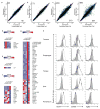Expression profiling of constitutive mast cells reveals a unique identity within the immune system
- PMID: 27135604
- PMCID: PMC5045264
- DOI: 10.1038/ni.3445
Expression profiling of constitutive mast cells reveals a unique identity within the immune system
Abstract
Mast cells are evolutionarily ancient sentinel cells. Like basophils, mast cells express the high-affinity receptor for immunoglobulin E (IgE) and have been linked to host defense and diverse immune-system-mediated diseases. To better characterize the function of these cells, we assessed the transcriptional profiles of mast cells isolated from peripheral connective tissues and basophils isolated from spleen and blood. We found that mast cells were transcriptionally distinct, clustering independently from all other profiled cells, and that mast cells demonstrated considerably greater heterogeneity across tissues than previously appreciated. We observed minimal homology between mast cells and basophils, which shared more overlap with other circulating granulocytes than with mast cells. The derivation of mast-cell and basophil transcriptional signatures underscores their differential capacities to detect environmental signals and influence the inflammatory milieu.
Conflict of interest statement
The authors have no competing financial interest
Figures







References
-
- Heng TS, Painter MW Immunological Genome Project, C. The Immunological Genome Project: networks of gene expression in immune cells. Nat Immunol. 2008;9:1091–1094. - PubMed
-
- Voehringer D. Protective and pathological roles of mast cells and basophils. Nat Rev Immunol. 2013;13:362–375. - PubMed
-
- Cavalcante MC, et al. Occurrence of heparin in the invertebrate styela plicata (Tunicata) is restricted to cell layers facing the outside environment. An ancient role in defense? J Biol Chem. 2000;275:36189–36186. - PubMed
-
- Metcalfe DD, Baram D, Mekori YA. Mast cells. Physiol Rev. 1997;77:1033–1079. - PubMed

